Sitting to the northeast of Bologna in the Emilia Romagna region, Ferrara is often overlooked by visitors to northern Italy, despite being one of its most charming small cities. Awarded UNESCO World Cultural Heritage status for being a ‘superb example of a Renaissance city that has retained its historic centre intact’, culturally, Ferrara was one of Italy’s most important Renaissance city states. Today, its cobbled Roman streets, Renaissance palaces and extraordinary Estense Castle make it an excellent add on to any trip to northern Italy.
Thanks to the ruling Estense dynasty, Ferrara experienced a golden age in literature, politics, gastronomy and the arts which shaped the city we see today. But the city’s appeal lies as much in its vibrant atmosphere. Streets and piazzas are lively and energetic without the crowds of the busier Italian cities, and tourists (mainly Italian) are relatively few in number. From early evening, the main piazzas, pavement cafes and restaurants are humming with locals enjoying aperitivi and dinner.
Ferrara highlights
Castello Estense
Ferrara’s magnificent Estense Castle is exactly what you’d imagine a medieval castle to be, complete with moats, towers, drawbridges and dungeons. First constructed by Niccolò d’Este as a fortress, the imposing castle was adapted over the years and in time, became the residence of the Este family, embellished with roof terraces, four splendid towers and grand apartments. Today it still dominates the city and also provides some great views over the rooftops from the Torre dei Leoni.
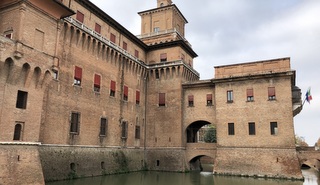
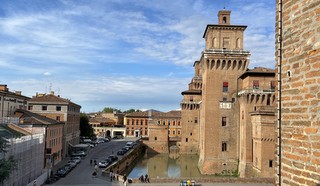
Ferrara’s ‘Delizie’
Ferrara’s ‘delizie’ were country houses, villas, palaces or castles intended by the Este dynasty to be places in which to spend ‘delight-filled leisure time’. The Palazzo dei Diamanti, designed by Biagio Rossetti, belonged to Sigismondo d’Este, the Duke’s brother. Perhaps best known for its magnificent façade, today it is also home to the National Picture Gallery and the Gallery of Modern and Contemporary Art. The Palazzo Schifanoia was another ‘delizia’. Originally built in the late 14th century and later expanded under Borso d’Este, the building houses the Salone dei Mesi (Room of the Months), one of Ferrara’s most famous frescoes.
The Duomo
Ferrara’s 12th century extraordinarily beautiful cathedral combines Romanesque and Gothic styles. Set alongside the imposing pink and white marble Renaissance campanile, the Duomo’s Loggia of the Merchants has been occupied by shops since medieval times.
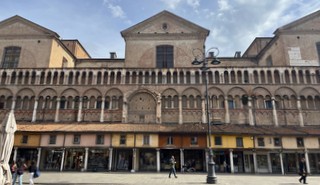
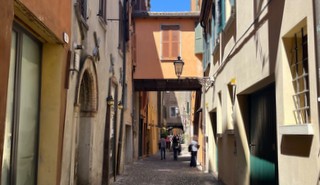
Via delle Volte
Ferrara’s historic centre is a warren of narrow, cobblestone streets. Of particular note is Via delle Volte which is framed by vaulted buildings which linked warehouses with homes.
National Holocaust Museum
With a long history of active Judaism, particularly during the Este reign in the 15th and 16th century, Ferrara was chosen as the location for Italy’s National Holocaust Museum (MEIS – Museo Nazionale dell’Ebraismo Italiano e della Shoah) which opened in in the city’s former prison in 2017. Ferrara’s Jewish ghetto lies in the heart of the city’s historic centre, in and around Via Mazzini.
Ferrara’s City Walls
Extending over a lengthy 9km, Ferrara’s city walls are amongst the most impressive in Italy, surpassed only by those in Lucca. Work up an appetite for a delicious dinner by walking the length of the city walls, past defensive towers, gates and gardens, or pick up a bike to cycle the route.
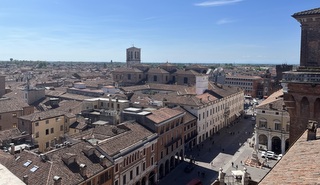
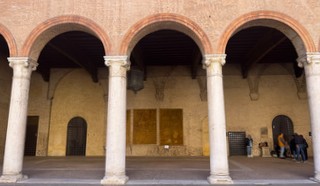
Eating and drinking in Ferrara
Don’t be surprised to find mortadella from Bologna, Parma ham, parmesan and Modican balsamic vinegar in shops and restaurants – Ferrara is only a short drive from each of these cities. But Ferrara also has its own very distinctive dishes and fiercely protected foodstuffs, with typical dishes combining sweet and savoury flavours.
What to order
Cappellacci alla zucca, handmade pasta parcels with a pumpkin filling, is the city’s number one pasta dish. Alternatively, try a traditional ‘Pasticcio di Maccheroni’, a kind of macaroni pie, with macaroni combined with meat sauce, bechamel, mushrooms, truffle and nutmeg, encased in shortcrust pastry.
A traditional main course is ‘salama di sugo’, a mixture of minced pork flavoured with red wine and spices, often served with mashed potato. And for dessert, chocolate ‘tenerina’. This soft cake, with a thin, crunchy outside crust, is eaten throughout Emilia Romagna but comes from Ferrara. Also available, naturally, as an ice-cream flavour in all good gelaterie! Winegrowing in Emilia Romagna is dominated by sparkling red Lambrusco but the region also produces red wines such as Sangiovese di Romagna DOC from Sangiovese grapes.
What is Ferrara best known for?
The Este dynasty
This iconic family ruled Ferrara from the 13th to the 16th century. The last duke of Ferrara, Alfonso II, died childless in 1597 bringing the dynasty to an end. During their period of rule, they transformed Ferrara into an intellectual and cultural centre, establishing the first university, patronising artists such as Piero della Francesca and Andrea Mantegna.
Girolamo Savonarola
Other famous figures from Ferrara include Girolamo Savonarola, a Dominican friar who preached against the moral corruption amongst the clergy and the Medici family. His criticism of the Roman Catholic Church resulted in his execution in 1498.
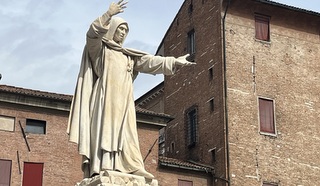
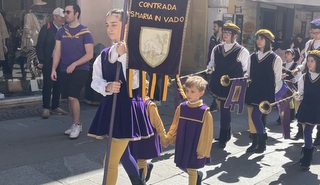
Literature in Ferrara
The city is closely associated with the poetry of Ludovico Ariosto who was born in Ferrara, and Torquato Tasso who spent many years in the court of Duke Alfonso II. Ferrara was also home to the prominent Italian novelist and poet, Giorgio Bassani, who set all his novels in the city, including his best known, ‘The Garden of the Finzi Continis’. More recently, British novelist Maggie O’Farrell conjured up an evocative image of Ferrara, the Este court and the Este ‘delizie’, the country villas owned by the Este dynasty, in her novel ‘The Marriage Portrait’.
The Palio in Ferrara
Ferrara is home to one of the oldest Palios in the world, with preparations, blessings, flag bearing practice sessions and processions starting 4 weeks before the event. The Palio takes place in the Piazza Ariostea on the last Sunday of May.
Getting to Ferrara
A short stay of around 2 days in the city is an excellent add-on at the beginning or end of our tours of Northern Tuscany and Ravenna, and Parma Tuscany and the Ligurian Sea.
If you’re travelling from overseas, Bologna airport is the closest to Ferrara. From there, a very efficient shuttle transfers you to Bologna Centrale train station. Trains from Bologna Centrale to Ferrara run every half hour and take around 30 minutes. Ferrara is well connected with most Italian cities. For all train information visit www.trenitalia.com which has an English version.
